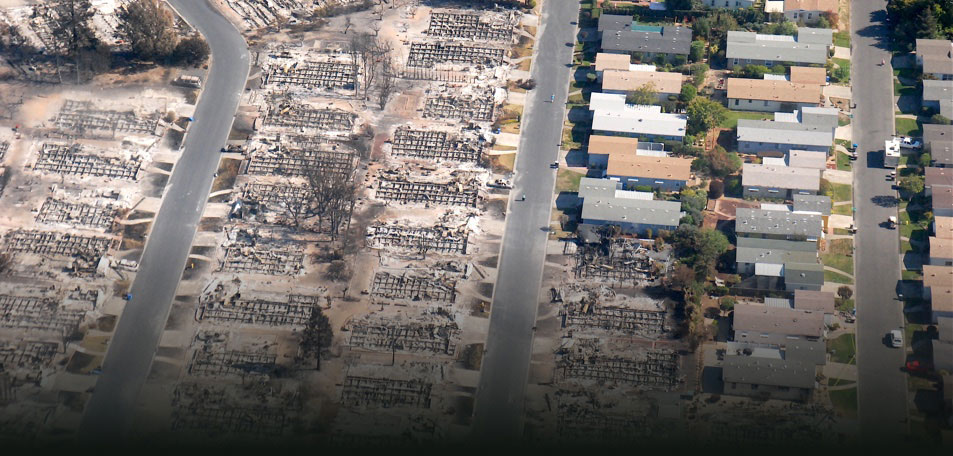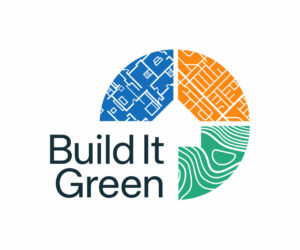
One month after wildfires tore through the North Bay in Napa and Sonoma, we are still grappling with the magnitude of loss and devastation. At least 42 people died and 8,900 structures were destroyed. Thousands of people were made homeless in a region that already had a housing shortage. At Build It Green, our staff in nearby Oakland, CA expressed deep concern, and I’m proud that members of our team have donated supplies or traveled north to assist in disaster relief efforts.
Yet in the aftermath of this tragedy, we’re already seeing a resilient and resolute spirit take hold across the North Bay: People are vowing to rebuild their homes and restore their communities as quickly as possible. At the same time, an important conversation is emerging, as builders, developers, and policymakers wrestle with how homes should be rebuilt.
I’d like to share some thoughts from Build It Green’s perspective.
Resilience is defined as the ability to bounce back from challenges, and the climate change crisis has made it painfully clear that we need more resilient communities. In a hotter, drier California, heat waves, droughts, severe storms and wildfires will unfortunately become more common.
In the residential sector, we must strengthen the durability of newly built homes. That means revisiting building codes for flood and fire resistance, and building new homes with a keen awareness of each community’s climate vulnerabilities.
The speed of rebuilding efforts is the primary focus right now—and understandably so—as local governments look for ways to streamline permitting and construction processes. But rebuilding right doesn’t necessarily need to slow down these efforts.
Millions of people in the greater Bay Area were exposed to dangerous air quality like never before. And after the fires, North Bay neighborhoods remain plagued by hazardous chemicals, ash and debris. Lead, asbestos and other toxins could leach into water supplies and soil. We must remember that these toxins were once inside peoples’ homes!
At Build It Green, we are passionate believers that a green home is a healthy home. Across the North Bay we must rebuild homes with health in focus; we must use more sustainable and healthy materials without formaldehyde and other chemicals; we must air seal and smartly ventilate homes to keep out pollutants and minimize dust, allergens, and mold. The fires taught us the destructive impact of poor outdoor air quality, and we know that, likewise, maintaining indoor air quality can have an incredible impact on health and quality of life. There are no expensive technologies required to achieve healthier homes—just smart building practices implemented by all builders and contractors. Build It Green wants to help building professionals understand and embrace these practices across California.
When you realize the scale of rebuilding that must take place in the North Bay, it begs the question: Where will we find thousands of new construction professionals to swing hammers, screw in sheetrock, and install HVAC systems? A dire shortage of skilled labor is looming ahead.
Existing workforce development programs must be expanded and fully funded. And we must seize the opportunity to train and employ residents from our most disadvantaged communities, where skyrocketing housing costs have hit vulnerable people the hardest. Putting people to work with good-paying construction jobs can also help fight displacement and homelessness.
Across the North Bay, we’re seeing elected officials and everyday community members step up to meet challenges that would have seemed unimaginable before October. It’s also worth noting that this region—Sonoma County in particular—has long been a national green building leader. Local government staff, builders, and contractors alike have helped pioneer practices and policies, and established the standards for what a green, healthy home looks like.
Now, as the region faces its greatest challenge ever, that green building leadership will pay dividends. Together, we can rebuild our communities to be healthier, more resilient and more sustainable. Build It Green is eager to assist in this effort.

Karin Burns is the Executive Director of Build It Green, a nonprofit with a mission to create a world of healthy and sustainable homes for all people.


Alex Coba
Communication Associate
As a proud California native from Stockton, Alex brings a wealth of experience and a versatile skill set. He has a solid communication background with a Bachelor of Arts in Journalism and Public Relations from California State University, Chico. Alex is adept at strategic communications and media relations, with experience gathering and sharing stories from his local communities that uplift the unique spirit and values of those places. He is excited to join Build It Green, where he can apply his talents to further BIG’s mission to help communities across California thrive